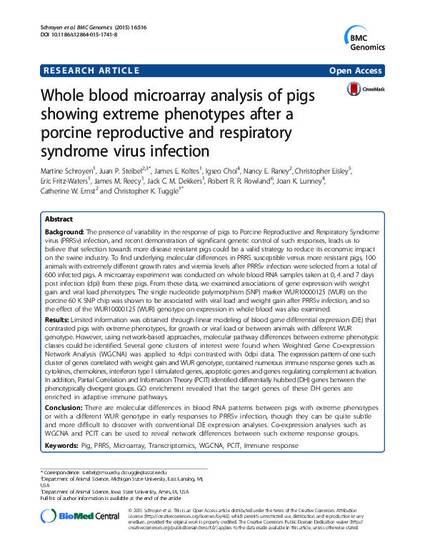
The presence of variability in the response of pigs to Porcine Reproductive and Respiratory Syndrome virus (PRRSv) infection, and recent demonstration of significant genetic control of such responses, leads us to believe that selection towards more disease resistant pigs could be a valid strategy to reduce its economic impact on the swine industry. To find underlying molecular differences in PRRS susceptible versus more resistant pigs, 100 animals with extremely different growth rates and viremia levels after PRRSv infection were selected from a total of 600 infected pigs. A microarray experiment was conducted on whole blood RNA samples taken at 0, 4 and 7 days post infection (dpi) from these pigs. From these data, we examined associations of gene expression with weight gain and viral load phenotypes. The single nucleotide polymorphism (SNP) marker WUR10000125 (WUR) on the porcine 60 K SNP chip was shown to be associated with viral load and weight gain after PRRSv infection, and so the effect of the WUR10000125 (WUR) genotype on expression in whole blood was also examined. Limited information was obtained through linear modeling of blood gene differential expression (DE) that contrasted pigs with extreme phenotypes, for growth or viral load or between animals with different WUR genotype. However, using network-based approaches, molecular pathway differences between extreme phenotypic classes could be identified. Several gene clusters of interest were found when Weighted Gene Co-expression Network Analysis (WGCNA) was applied to 4dpi contrasted with 0dpi data. The expression pattern of one such cluster of genes correlated with weight gain and WUR genotype, contained numerous immune response genes such as cytokines, chemokines, interferon type I stimulated genes, apoptotic genes and genes regulating complement activation. In addition, Partial Correlation and Information Theory (PCIT) identified differentially hubbed (DH) genes between the phenotypically divergent groups. GO enrichment revealed that the target genes of these DH genes are enriched in adaptive immune pathways. There are molecular differences in blood RNA patterns between pigs with extreme phenotypes or with a different WUR genotype in early responses to PRRSv infection, though they can be quite subtle and more difficult to discover with conventional DE expression analyses. Co-expression analyses such as WGCNA and PCIT can be used to reveal network differences between such extreme response groups.
Available at: http://works.bepress.com/james_reecy/87/

This article is from BMC Genomics 16 (2015): 516, doi:10.1186/s12864-015-1741-8.